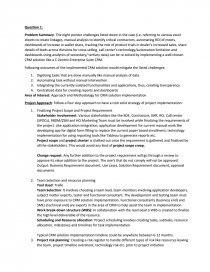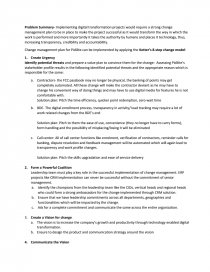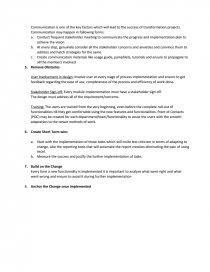Pidilite Case Study
Essay by Anita Narayan • January 16, 2018 • Case Study • 1,236 Words (5 Pages) • 1,209 Views
Question 1:
Problem Summary- The eight pointer challenges listed down in the case (i.e. referring to various excel sheets to create linkages, manual analysis to identify critical contractors, automating ROI of meets, dashboards of increase in wallet share, tracking the role of product trials in dealer’s increased sales, share details of leads across divisions for cross-selling, call-center’s technology/automation limitation and dashboards using analytics of secondary/ tertiary data) can be re-solved by implementing a well-chosen CRM solution like a C-Zentrix Enterprise Suite CRM.
Following outcomes of the implemented CRM solution would mitigate the listed challenges:
- Digitizing tasks that are done manually like manual analysis of data
- Automating task without manual intervention
- Integrating the currently isolated functionalities and applications, thus, creating transparency
- Centralized data for creating reports and dashboards
Area of Interest: Approach and Methodology for CRM solution implementation
Project Approach: Follow a four step approach to have a rock solid strategy of project implementation:
- Finalizing Project Scope and Project Requirement
Stakeholder Involvement: Various stakeholders like the BDE, Contractors, IMR, RCI, Call center (SPOCs), RBDM/ZSM and HO Marketing Team must be involved while finalizing the requirements of the project. Like application integration, application development for current manual work like developing app for digital form filling to replace the current paper based enrollment, technology implementation for using reporting tools like Tableau to generate reports etc.
Project scope and project charter is chalked out once the requirement is gathered and finalized by all the stakeholders. This would avoid any kind of project scope creep.
Change request: Any further addition to the project requirement will go through a review to approve its value addition to the project. The one’s that do not comply will not be approved.
Output: Business Requirement document, Use cases, Solution Requirement document, approval documents
- Team Selection and resource planning
Tool Used: Trello
Team Selection: It involves choosing a team lead, team members involving application developers, subject matter experts, tester and functional consultant. The development and testing team must have prior exposure to CRM solution implementation. Functional consultants (business end) and SMEs (technical end) are experts in the area of CRM to help assist the team in implementation.
Work break-down structure (WBS): In collaboration with the team lead a WBS is created to finalize the high level deliverable of the resource.
Scheduling and Resource allocation: Project scheduling involves creating tasks, subtasks, resource allocation, milestones and timelines for task implementation.
Typical CRM solution implementation timeline could be anywhere between 6-12 months.
- Project risk planning: Creating a risk register to handle different types of risk like resources leaving the team, project timeline overshoot, technology risk etc. prior to project initiation
Tool Used: Online risk register
- Monitor and control: This is where the implementation phase crops in. Continuous monitoring and weekly meetings such as the status report meeting to check the progress and handle unplanned blockages if any in the project.
Project Implementation Methodology: Choosing an appropriate method/ SDLC model for the CRM solution implementation depends on factors like- organization culture, infrastructure readiness, resource availability and their skill sets. Assuming CRM is the first of its kind implementation in Pidilite and the risk appetite of Pidilite is low, I suggest a twostep implementation method of CRM solution:
- Pilot Implementation
- Enterprise wide implementation
SDLC Model: Waterfall Model
[pic 1]
A rapid or an agile model may not work well for a large scale implementation of critical application like a CRM.
Implementation plan for the 2-step approach:
Project feature | Pilot Implementation | Enterprise wide Implementation |
Number of users | Less than 25 | More than 25 |
Business Needs | Trial tested | Well defined |
Data Cleansing | Not necessary | Required |
Customization | Only critical features | All of finalized features |
Integration to existing ERPs | Not required | Required |
Time frame | 1 month or lesser | 3-6 months |
Scale of Implementation | Limited to an area/department | Enterprise wide |
Question 2:
Problem Summary- Implementing digital transformation projects would require a strong change management plan to be in place to make the project successful as it would transform the way in which the work is performed and more importantly it takes the authority by humans and places it technology, thus, increasing transparency, credibility and accountability.
Change management plan for Pidilite can be implemented by applying the Kotter’s 8-step change model:
- Create Urgency
Identify potential threats and prepare a value plan to convince them for the change: Assessing Pidilite’s stakeholder profile results in the following identified potential threats and the appropriate reason which is responsible for the same:
- Contractors- the FCC passbook may no longer be physical, the banking of points may get completely automated. All these change will make the contractor deviant as he may have to change his convenient way of doing things and may have to use digital media for features he is not comfortable with.
Solution plan: Pitch the time efficiency, quicker point redemption, zero-wait time
- BDE- The digital enrollment process, transparency in activity/ lead tracking may require a lot of work related changes from the BDE’s end
Solution plan: Pitch to them the ease of use, convenience (they no longer have to carry forms), form handling and the possibility of misplacing/losing it will be eliminated
- Call center: All of call center functions like enrolment, verification of contractors, reminder calls for banking, dispute resolution and feedback management will be automated which will again lead to transparency and work profile changes.
Solution plan: Pitch the skills upgradation and ease of service delivery
...
...




